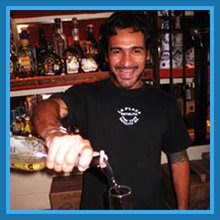 If you are any kind of self respecting Drinker, you not only know your bartender's name, but you think so highly of him or her, that their name could be the name you give one of your future children, Boy or girl... Yes, the relationship with your Bartender is paramount to a good drinking experience, and more so with the success and return-ability of any great bar.
If you are any kind of self respecting Drinker, you not only know your bartender's name, but you think so highly of him or her, that their name could be the name you give one of your future children, Boy or girl... Yes, the relationship with your Bartender is paramount to a good drinking experience, and more so with the success and return-ability of any great bar.Those of my Tribe and designation have clocked enough hours at a Bar that much like a lover or good friend, it truly matters who your Bartender is, how he treats you, and what they represent themselves as. Whether it's Jeff at the Crow Bar, Annie at Fulton Street, or Craig at the Cactus Club, I'll never forget the great Bartenders in my life...and neither should you.
Enter Miguel. Born Miguel Sanchez Origel in Aguas Calientes, Mexico, I first met Miguel when I myself was Bartending at the long dead Sayulita Lounge, as he came in to borrow or share ingredients for where he was bartending, my now dear Sayulita Fish Taco. Miguel is the father of his 6 year old son Diego, and the kind of Dad any kid would love - he has been a bartender for 14 years, starting when he was 18 working in bars, moving into bartending after the first few years. We worked together shortly at the Lounge, and now he pours my poison at the S.F.T. Tequila Bar, and I couldn't be happier. A hardcore surfer since his early teens, he truly personifies the lifestyle that everyone wants... work hard, keep in funds, and surf every free minute you have. I don't surf, but with Miguel, it doesn't matter, he is gonna treat you like you DO surf, not like you DON'T surf, and tell you all about the waves in the most glorious fashion... and that in itself is the biggest compliment he gives you, and I can give him. He is the same good guy, it's us who are different. We have gotten chances to discuss much as he pours my Tequila, or as we share a glass, and the conversations over a drink is one of the true treats of a Tequila bar such as S.F.T. Though he used to drink Tequila as a younger man only to party and get wasted as many of us, he has developed a taste for the good stuff, and appreciates the subtle differences in the myriad variety of bottles.
Favorite Tequila: Casa Noble Reposado (pictured above in the blue bottle). "Suave, hints of chocolate, cinnamon, and vanilla"
Worst Tequila memory: When he was young, he used to drink liter after liter of bad tequila, and
 extreme amounts of beer - this led to classic vomiting sessions lasting hours!
extreme amounts of beer - this led to classic vomiting sessions lasting hours!Best Tequila memory: At a family gathering for a wedding, in his home town of Aguas Calientes, in a local pueblo called Calvillo. The Tequila was a no-name Tequila for the wedding, but the fact that his family was all there, great food, Mariachis playing, the Tequila was an uplifting factor that had everyone bonding and sharing in the moment.
Thoughts on Sayulita: "Sayulita crece, pero yo cresco con ella" - "Sayulita grows, but I grow with her" - words to live by in our great little town!
Miguel is behind the Bar every single day but Sunday. No kidding. Come to Sayulita, stop by the S.F.T. Tequila Bar, have him pick out your poison, and tell 'em Gabbi sent you.









